学术论文写作与投稿:JFE Tips
学术论文的投稿技巧
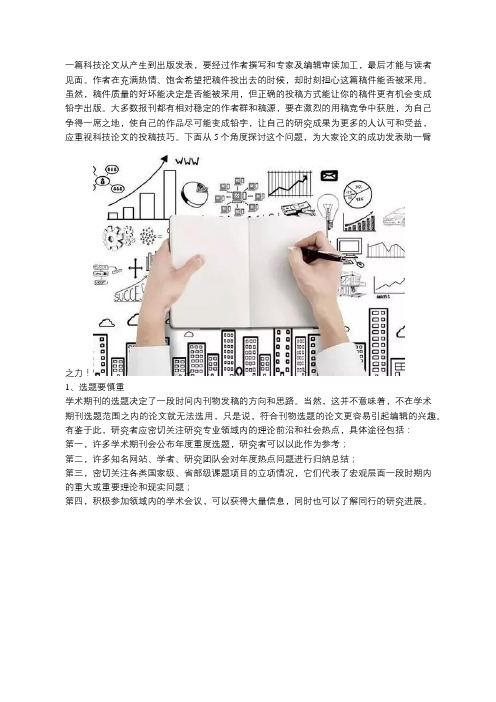
一篇科技论文从产生到出版发表,要经过作者撰写和专家及编辑审读加工,最后才能与读者见面。
作者在充满热情、饱含希望把稿件投出去的时候,却时刻担心这篇稿件能否被采用。
虽然,稿件质量的好坏能决定是否能被采用,但正确的投稿方式能让你的稿件更有机会变成铅字出版。
大多数报刊都有相对稳定的作者群和稿源,要在激烈的用稿竞争中获胜,为自己争得一席之地,使自己的作品尽可能变成铅字,让自己的研究成果为更多的人认可和受益,应重视科技论文的投稿技巧。
下面从5个角度探讨这个问题,为大家论文的成功发表助一臂之力!1、选题要慎重学术期刊的选题决定了一段时间内刊物发稿的方向和思路。
当然,这并不意味着,不在学术期刊选题范围之内的论文就无法选用,只是说,符合刊物选题的论文更容易引起编辑的兴趣。
有鉴于此,研究者应密切关注研究专业领域内的理论前沿和社会热点,具体途径包括:第一,许多学术期刊会公布年度重度选题,研究者可以以此作为参考;第二,许多知名网站、学者、研究团队会对年度热点问题进行归纳总结;第三,密切关注各类国家级、省部级课题项目的立项情况,它们代表了宏观层面一段时期内的重大或重要理论和现实问题;第四,积极参加领域内的学术会议,可以获得大量信息,同时也可以了解同行的研究进展。
2、论述要严谨选题确定下来后,作者要进行认真的调查研究、科学实验,最终形成学术论文。
论文在写作过程中,论述一定要严谨。
论述严谨主要表现在两个方面:(1)结构合乎要求,论证合乎逻辑。
必须按照论文的写作要求去写,要有引言部分、正文部分和结论部分。
引言部分注意做到开门见山、起笔切题、言简意赅、突出重点、不能铺垫太远。
正文部分是论文的核心部分,主要包括论点、论据和论证三大要素。
论文要有总论点即论文的主题,论据是证明论点的材料,论证是用论据来证明论点的推理过程。
由于论文作者研究的学科领域不同,撰写的论文在内容呈现上不能做统一规定,但总的要求是:提出论点,通过论据来对论点加以层层论证。
学术论文写作的方法与技巧

学术论文写作的方法与技巧学术论文是学术研究成果的重要表现形式之一,它是通过深入探究特定问题,发表学术性文章以达到交流思想、增进学术研究的论文。
然而,学术论文写作不仅要具有良好的学术水平,而且还需要具备一定的写作技巧。
本文将探讨学术论文写作的方法与技巧。
一、选择正确的主题学术论文写作的第一步是选择正确的主题。
一个好的主题是写作的基础。
如何选择正确的主题呢?首先我们要明确自己的研究方向,然后通过各种途径,如阅读文献、交流研究领域内的专家等方式,来寻找并确定一个好的主题。
在选择论文主题时,还应该考虑以下几点:1.主题不应过于宏大或笼统,否则会难以展开讨论和研究;2.主题应该紧密地与自己的研究方向相关,以利于撰写具有说服力的论文;3.主题应该有一定的研究意义和实际应用价值。
二、搜集相关文献论文搜集文献是非常关键的一步,因为它能够确保论文的可信度和准确性。
在搜集文献时,应该遵循以下步骤:1.利用各种学术数据库和网络资源,如CNKI、SCI、Web of Science等。
这些资源可以方便地获取到专业的、有权威性的文献,以确保论文的真实性和可信度。
2.阅读文献时,应该注意筛选,以确保选取的文章信息与论文的主题相符合。
同时,还要对文献进行详细的整理、分类和标注,以方便后续的阅读和参考。
3.熟练掌握文献的引用格式。
不同的学术领域和期刊的引用格式可能都不相同,所以要确保自己掌握了正确的引用格式,以便论文的准确和规范。
三、建立论文的大纲通过搜集文献和讨论研究方向,可以建立一个大致的论文框架。
在建立大纲时,需要根据论文的主题、研究内容、结论等方面确定论文的主体结构和逻辑。
在编写大纲的过程中,应该合理地分配每个章节所要阐述的内容的比例,确保论文的整体性和完整性。
四、论文的写作写作时要注意的问题很多,以下讨论比较重要的几点:1.语言表达:在写作时,要遵循清晰、精准的原则。
通过篇章的布局、段落的划分、语句的连接等方式,使论文的表达更加简明、直观、准确,避免文字的繁琐和难以理解。
大学生学术论文写作与发表技巧

大学生学术论文写作与发表技巧学术论文写作和发表是每个大学生都需要掌握的重要技能。
本文将为大家介绍一些实用的技巧,帮助提升学术论文的质量和发表的成功率。
一、选择合适的研究主题选择一个合适的研究主题是学术论文写作的首要步骤。
首先,你需要对该领域进行广泛的文献调研,了解前人的研究现状和未解决的问题。
其次,要选择一个有足够研究价值和创新性的主题,同时要考虑研究方法和资源的可行性。
二、制定合理的研究方法在论文写作中,研究方法的合理性对于论文的质量至关重要。
你需要详细描述你的研究方法,并清晰地解释为什么选择了这种方法。
同时,要注意方法的可重复性和效度,尽量避免主观判断和偏见的影响。
三、合理组织论文结构良好的结构对于学术论文的阅读和理解至关重要。
一篇论文应该包括引言、文献综述、研究方法、结果分析和讨论这几个部分。
在写作时,可以采用递进的方式,逐步展开论点,并通过恰当的段落过渡使整篇文章具有连贯性。
四、精细化论文写作精细化论文写作是提高论文质量的关键步骤。
首先,要注意语法和拼写错误,避免对读者阅读造成困扰。
其次,用精确的词汇和学术表达方式来描述研究结果,避免模糊和不明确的陈述。
另外,合理使用图表和公式来展示数据和结果,提升论文可读性。
五、注重文献引用和参考文献的规范学术论文需要准确引用他人的研究成果。
在引用时,要遵循规范的引用标准,包括作者、年份和页码信息。
同时,在论文的末尾列出参考文献,按照一定的格式(如APA、MLA等)排列,确保完整且准确。
六、选择合适的发表渠道发表学术论文是展示研究成果和学术影响力的重要方式。
选择合适的发表渠道可以提高论文被引用和阅读的机会。
学生可以选择投稿到学术期刊、会议论文集或申请学术奖项等方式来发表论文。
此外,也可以在学术社交网络上广泛交流和分享研究成果。
七、与导师和同行进行交流和讨论与导师和同行进行交流和讨论可以帮助你改进论文并获得更多的反馈意见。
通过与专家和同行的交流,可以使论文更加全面和准确。
第八章学术论文的撰写与投稿

• 2、指示性文摘:是指明论文的论题、所取 得成果的性质和水平的摘要。这类文摘一 般只对原始论文作扼要说明,其目的是使 读者对该研究的主要内容有一个轮廓性的 了解。一般不做定量的报道,不涉及研究 方法、结果和结论。这类文摘的内容主要 是根据论文的引言、各级标题、结语来编 写,它主要的作用在于对读者起到一定的 提示性摘要,帮助读者依此线索去查找阅 读论文全篇。篇幅以100-200字为宜。
• 2.1.1学术论文的编写的相关要求 • 首先,论文稿应当采用A4标准大小的白纸进行单面缮写 或计算机打印,以便阅读和作相关处理。同时要求稿纸的 四周留足空白边缘,便于装订、复制及读者批注。 • 其次,论文的章节编号需要按照GB1.1《标准化工作 导则标准编写基本规定》第8章“标准条文的编排”的有 关规定执行,即采用阿拉伯数字分级编号;不同层次的2 个数字之间用下圆点(.)分隔开,如“1”、 “1.1”、“2”、“2.1”、“2.1.1”等, 各层次的标题序号均左顶格排写,最后一个序号后需空一 个字距接排标题。 • 最后,从总体结构上看,一篇学术论文一般应当由前置部 分、主体部分、附录部分、结尾部分组成。
• 3.4综合分析研究,做出相关处理。 • 对搜集来的专题资料进行综合分析、研究 整理,选出值得利用的部分,进一步吸收、 消化。 • 3.5动笔行文成章,修改完善定稿。 • 根据自己的研究、思考,按照拟订好并不 断完善的大纲及已经掌握的比较系统全面 的文献信息,可以撰写出论文的初稿。
• 论文的修改应考虑以下几个方面的问题: 一是论点是否明确;二是论据是否充分; 三是论证手段是否正确,推理是否严密, 分析是否合理;四是条理层次是否清楚, 结构是否完整、紧凑,布局是否得当,前 后是否照应,各部分的联系是否连贯自然; 五是题目是否贴切,字、词、句、标点符 号是否正确,语言是否准确。
写好学术期刊论文投稿信的技巧
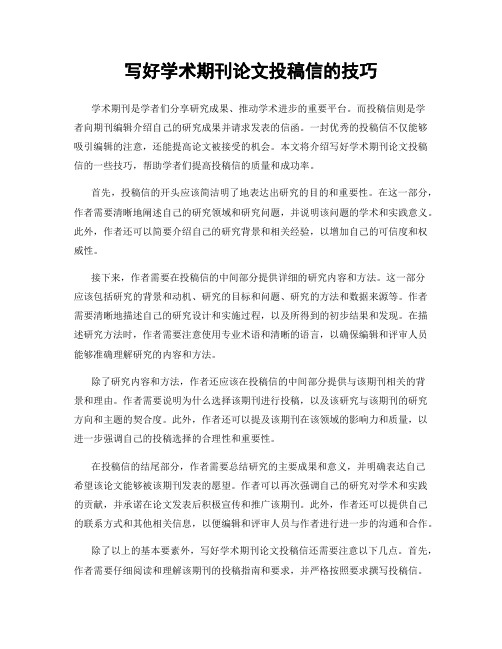
写好学术期刊论文投稿信的技巧学术期刊是学者们分享研究成果、推动学术进步的重要平台。
而投稿信则是学者向期刊编辑介绍自己的研究成果并请求发表的信函。
一封优秀的投稿信不仅能够吸引编辑的注意,还能提高论文被接受的机会。
本文将介绍写好学术期刊论文投稿信的一些技巧,帮助学者们提高投稿信的质量和成功率。
首先,投稿信的开头应该简洁明了地表达出研究的目的和重要性。
在这一部分,作者需要清晰地阐述自己的研究领域和研究问题,并说明该问题的学术和实践意义。
此外,作者还可以简要介绍自己的研究背景和相关经验,以增加自己的可信度和权威性。
接下来,作者需要在投稿信的中间部分提供详细的研究内容和方法。
这一部分应该包括研究的背景和动机、研究的目标和问题、研究的方法和数据来源等。
作者需要清晰地描述自己的研究设计和实施过程,以及所得到的初步结果和发现。
在描述研究方法时,作者需要注意使用专业术语和清晰的语言,以确保编辑和评审人员能够准确理解研究的内容和方法。
除了研究内容和方法,作者还应该在投稿信的中间部分提供与该期刊相关的背景和理由。
作者需要说明为什么选择该期刊进行投稿,以及该研究与该期刊的研究方向和主题的契合度。
此外,作者还可以提及该期刊在该领域的影响力和质量,以进一步强调自己的投稿选择的合理性和重要性。
在投稿信的结尾部分,作者需要总结研究的主要成果和意义,并明确表达自己希望该论文能够被该期刊发表的愿望。
作者可以再次强调自己的研究对学术和实践的贡献,并承诺在论文发表后积极宣传和推广该期刊。
此外,作者还可以提供自己的联系方式和其他相关信息,以便编辑和评审人员与作者进行进一步的沟通和合作。
除了以上的基本要素外,写好学术期刊论文投稿信还需要注意以下几点。
首先,作者需要仔细阅读和理解该期刊的投稿指南和要求,并严格按照要求撰写投稿信。
其次,作者需要确保投稿信的语言流畅、准确,没有语法和拼写错误。
投稿信是作者与编辑和评审人员的第一次接触,语言的规范性和准确性对于留下良好的第一印象非常重要。
学术论文投稿信范文学术论文投稿信的范本及写作技巧解析

学术论文投稿信范文学术论文投稿信的范本及写作技巧解析学术论文投稿信范文及写作技巧解析在学术界,学术论文的发表对于学者来说意义重大,不仅是学术成果的展示,更是学术地位的标志。
而学术论文的投稿信则是为了将自己的研究成果呈现给学术期刊或会议,争取发表的机会。
本文将为您提供一份学术论文投稿信的范例,并解析撰写此类信件的技巧。
一、学术论文投稿信的基本结构学术论文投稿信一般分为以下几个部分:首先是信头,包括作者姓名、职称、所在机构、通讯地址、联系方式等;接下来是称呼,即收信人的姓名;然后是引言段落,简要介绍自己的研究领域和兴趣,以及选取该期刊或会议的原因;再往下是主体段落,详细展示论文的研究内容、创新点和意义;最后是结束语,表示感谢,并提供联系方式以方便进一步沟通。
二、学术论文投稿信的写作技巧1. 简明扼要:投稿信应该尽量保持简洁清晰,避免冗长的句子和复杂的专业词汇,让读者一目了然。
2. 突出亮点:在主体段落中,重点突出论文的创新点和研究成果,侧重阐述研究的重要性和应用前景。
3. 自信而谦虚:在投稿信中应展示自信,但同时也要谦虚,承认可能存在的不足,并表达对审稿人的建设性意见的期待。
4. 针对性投稿:在引言段落中,要明确解释选择该期刊或会议的原因,并说明自己的研究与该期刊或会议的主题或范围有关。
5. 语言流畅:要注意用通俗而精确的语言进行表达,避免学术术语的过度使用,以保证广泛读者的理解。
三、学术论文投稿信的范本尊敬的XXX编辑:您好!我是XXX大学的XXX,我写信是为了向贵刊投稿我最近完成的论文,题目为《XXX》。
首先,我向贵刊投稿此文是基于对贵刊的了解和对我研究领域的研究兴趣。
我注意到贵刊一直关注并发表了许多与我的研究方向相关的优秀论文,而且贵刊的学术影响力和知名度在该领域具有重要地位。
对于我个人而言,能够将我的研究成果发表在贵刊上将对我的研究生涯产生积极的影响。
本文是基于我近年来的研究工作所完成的,主要围绕XXX展开。
学术论文投稿信范文及投稿技巧分享

学术论文投稿信范文及投稿技巧分享尊敬的编辑,您好!我是一名经验丰富的撰稿专家,具备创作深度文章的专业知识与实践技巧。
在您的要求下,我将为您撰写一篇题目为“学术论文投稿信范文及投稿技巧分享”的文章,以通俗而精确的语言向广大读者阐述相关内容。
学术论文的投稿信是学术界常见的一种书信形式,用于向学术期刊或会议投稿并介绍自己的研究成果。
一封优秀的投稿信可以有效吸引编辑的注意力,提高论文被接收的概率。
接下来,我将分享一篇范文及一些投稿技巧,帮助读者更好地撰写自己的投稿信。
【文章正文】尊敬的编辑,您好!非常感谢您抽出时间阅读我的投稿信。
我是XXX大学XXX 专业的研究生,我非常荣幸向您推荐我所完成的研究论文《XXX》。
我相信该研究能够为贵刊/readers提供有价值的见解。
该论文研究了XXX领域的XXX问题。
通过综合运用理论分析和实证实证研究方法,我们发现XXX。
这一发现不仅对于现有研究具有学术价值,而且在实际应用中也具有重要意义。
我们的研究结果对于XXX产业的发展和政策制定具有指导意义。
首先,我们在理论层面对XXX问题进行深入剖析。
通过文献综述,我们界定了XXX的定义,并对其影响因素和机制进行了详细阐述。
在此基础上,我们提出了XXXX理论框架,并运用了XXXX方法对其进行实证研究。
其次,我们采用了XXXX方法,收集了来自XXX的大样本数据。
通过数据分析,我们验证了XXXX的有效性。
结果表明,XXX因素对XXX具有显著影响,这与我们的研究假设一致。
此外,我们还通过XXXX方法对数据进行了深入分析,以进一步解释XXX和XXX之间的关系。
最后,在讨论部分,我们对研究结果进行了更深入的分析和解释。
我们探讨了XXX对XXX的影响机制,并提出了一些建议以促进XXX的发展。
这些讨论和建议将为相关领域的研究者和从业者提供有益信息,并可能引发新的研究方向。
基于以上分析,我坚信该论文具有足够的学术和应用价值,适合贵刊的发表。
我真诚希望您能给予论文关注,并给予我们一个机会向广大读者传播我们的研究成果。
学术论文写作与发表

学术论文写作与发表学术论文写作和发表是每个研究人员必须面对的挑战。
以下是一些关于学术论文写作和发表的建议:1.选择一个好的研究主题:选择一个有足够研究空间和价值的研究主题,这可以让你在写作和发表论文时更有优势。
同时,研究主题应该是你感兴趣的,这样你才能投入足够的精力和时间来完成研究。
2.进行文献综述:在进行研究之前,你需要进行文献综述。
文献综述是对已有研究的概述和分析。
通过文献综述,你可以了解到已有研究的研究空间和不足之处,从而为你的研究提供指导和启示。
3.论文结构:学术论文的结构应该完整、层次分明、逻辑严密、条理清晰。
一篇好的学术论文应该包括引言、文献综述、研究方法、研究结果和讨论、结论等部分。
4.写作技巧:在写作过程中,需要注意语言表达、语法和拼写等技巧。
同时,应该注意论文的格式要求,包括字体、字号、行距、页边距等。
5.投稿技巧:在投稿过程中,需要注意期刊的选择、论文题目的选择、摘要的撰写、关键词的选择等技巧。
同时,应该注意投稿的流程和规定,包括提交材料、缴纳费用等。
6.与同行交流:在写作和发表论文的过程中,与同行交流是很有帮助的。
你可以向其他研究人员请教问题、分享研究成果、讨论研究思路等。
7.坚持不懈:发表论文并不是一件容易的事情,需要付出大量的时间和精力。
因此,你需要坚持不懈地努力,直到你的论文被接受并发表。
总之,学术论文写作和发表是一个复杂的过程,需要研究人员付出大量的努力和时间。
通过选择好的研究主题、进行文献综述、掌握论文结构和写作技巧、了解投稿流程和规定以及与同行交流等步骤,你可以更好地完成学术论文的写作和发表。
学术论文写作的规范和技巧

学术论文写作的规范和技巧一、引言学术论文作为一种重要的学术文献形式,被广泛应用于各个学科领域,是表达学者思想、展示研究成果与交流学术观点的重要渠道。
本文旨在探讨学术论文写作规范与技巧,以帮助学术作者写出高质量的学术论文。
二、学术论文规范学术论文规范是学术论文写作的重要基础,包括论文格式、写作语言、引用格式等,下文将针对这些规范进行详细介绍。
1. 论文格式论文格式是学术论文规范的基础,要求论文的字体、字号、行距、页边距等符合国际学术界的标准,以美观、清晰、易读为目标。
比如,一般要求字体为12号宋体或Times New Roman,1.5倍行距或双倍行距,页边距上下左右均为2.54厘米等。
同时,还需遵循学术期刊或学术会议的特定格式要求,如标题居中,段落首行缩进等。
2. 写作语言写作语言是学术文献公正、客观、精准的表现方式,是学术论文写作规范的重要环节。
要求学术语言规范、准确、简洁明了,如使用正确的词汇和语法,避免使用口语化表达和生活化用语,并注重语言逻辑和谨慎表达。
3. 引用格式学术论文需要在论据支撑上形成严谨的观点体系。
而这些论据多数实现通过文献引用。
引文支持文献的准确性,同时为他人学术贡献确定范围。
所以引用格式是学术论文规范中一项重要的部分。
常用的引文格式有MLA、APA、Chicago等格式要求,作者要明确引文格式的要求,尊重引用规范,避免引言不清、重复计数等问题出现。
三、学术论文写作技巧学术论文写作的技巧特指如何写出高质量的学术论文,下文总结了一些学术论文写作技巧。
1. 规划论文结构写作时,要先规划论文结构,再开始写作。
要求论文满足开篇清晰、中间贯穿、结尾明晰的三大特点,可以把论文分为:导言、正文、结论三个部分,每个部分要掌握好篇幅,阐述内容要脉络清晰,不要拖沓,不要重复。
2. 注意图表、数据的清晰性除文字外,图表、数据在学术论文中也占有重要位置。
图表数据要求布局清晰,数据准确,通俗易懂,不要追求华丽,而是要追求清晰。
学术论文写作指南:高质量学术论文撰写的技巧与方法
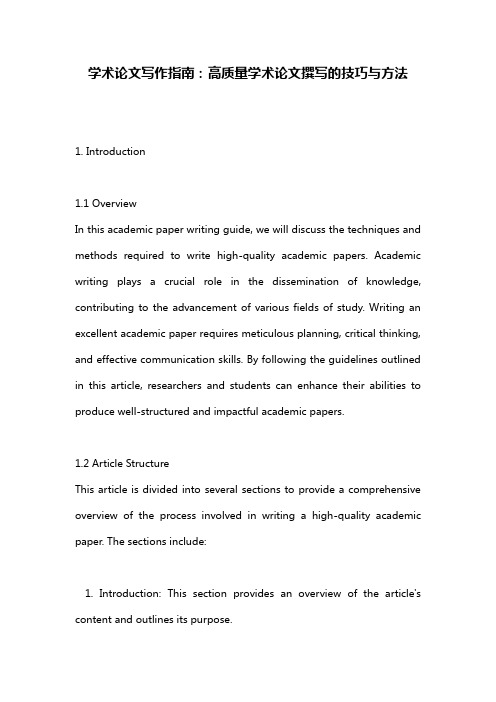
学术论文写作指南:高质量学术论文撰写的技巧与方法1. Introduction1.1 OverviewIn this academic paper writing guide, we will discuss the techniques and methods required to write high-quality academic papers. Academic writing plays a crucial role in the dissemination of knowledge, contributing to the advancement of various fields of study. Writing an excellent academic paper requires meticulous planning, critical thinking, and effective communication skills. By following the guidelines outlined in this article, researchers and students can enhance their abilities to produce well-structured and impactful academic papers.1.2 Article StructureThis article is divided into several sections to provide a comprehensive overview of the process involved in writing a high-quality academic paper. The sections include:1. Introduction: This section provides an overview of the article's content and outlines its purpose.2. Preparatory Stage for Paper Writing: Here, we will explore the initial steps required before commencing the actual writing process, such as selecting a research topic, collecting relevant literature materials, and creating a writing plan.3. Techniques for Academic Paper Writing: In this section, we will delve into specific techniques essential for effective academic writing. These techniques include expressing clear and concise arguments, incorporating appropriate citation practices, and maintaining logical coherence throughout the paper.4. Methods for Improving Academic Paper Quality: Here, we will discuss various methods researchers can employ to enhance the quality of their academic papers. These methods involve regular revision and proofreading, seeking peer reviews or feedback, and paying attention to details regarding language expression and formatting.5. Conclusion and Outlook: Finally, we will summarize key points discussed in the main body of the article while also providing future research directions and concluding remarks.1.3 PurposeThe purpose of this article is to serve as a comprehensive guide for individuals engaged in academic research who aspire to write exceptional scholarly papers that stand out within their respective domains. By emphasizing both theoretical knowledge on academic writing as well as practical strategies, readers will gain a solid foundation and acquire the necessary skills to produce high-quality papers. With this guide's insights, researchers will be equipped to contribute meaningful work to their fields of study while effectively communicating their findings and ideas.2. 论文写作准备阶段2.1 确定研究课题在开始撰写学术论文之前,首先需要确定一个明确的研究课题。
学术论文写作技巧[优秀范文5篇]
![学术论文写作技巧[优秀范文5篇]](https://img.taocdn.com/s3/m/baa21ee1b04e852458fb770bf78a6529647d35f4.png)
学术论文写作技巧[优秀范文5篇]第一篇:学术论文写作技巧第一条,先要围绕着论题去占有和选择材料。
也就是说,当你的论题已经确定以后,第一,围绕着立论去占有材料,多多益善的去看。
有的论题是来自老师已经拟订好的题目。
有相当一部分学生是自己确立论题的,先积累材料,再有论点。
一旦立论确立了以后,再回过头来去占有材料。
在占有材料方面跟我《基础写作》里讲的有相通的地方。
第一要占有材料,占有研究对象的真实的材料。
比如你要研究某个作家,某个阶段的几部作品,就将这几部作品拿来进行深入细致的研读,进一步来确定自己的论点。
如果你的论文是报告类的,不是纯理论性的,用实验报告、调查报告、总结的形式来写论文的,那么你的调查材料、实验材料也要占有。
第二,要对研究对象的外延材料占有。
比如你要研究的是作家作品的话,那么你就要对作家写作的背景材料,包括政治经济背景、文艺思潮背景等。
还有作家谈自己创作的材料,还有他人已经研究过的材料等。
有了这些材料,你就可以做到知人论世,可以使自己在研究当中尽量公允,不带偏见。
所以,充分占有材料,也就使你的论据更充分。
这样你将来的论证就会更加深广。
第三,在有材料的基础上要选择材料。
决不能只要有材料就统统拉进来。
这是你们写论文常出现的问题。
比如让你写一万字,你可能写到五六万字。
象刚才那个学生一样,写出六万字,太丰富了。
把握不住自己的时候,可以让老师来帮助你,告诉你哪些能用,哪些不能用。
多占有材料总比没有材料写不出来要好,因为删总是好删的。
在材料多的情况下,你就选更好的材料。
、选择论文的类型。
第二项准备工作就是选择论文的类型。
毕业论文的类型一是学术性论文,二是报告性论文。
应用性比较少的科目来说比较容易做成学术型论文,比如对作家、作品的研究,对诗派的研究。
应用性比较强的学科,比如教学领域、新闻领域、治疗科学和实验等,论文一般写成调查性的或总结性的,我将它概括为报告型论文。
杂志上发表的3000来字的论文,一般就是报告型的论文。
学术论文的写作要求及技巧

学术论文的写作要求及技巧学术论文是一种系统性的学术写作,旨在研究一些问题或回答一些假设,并通过论证和分析提供可靠的结论。
下面是学术论文写作的要求和技巧:1.主题选择:选择一个狭窄但有足够研究空间的主题。
确保你对这个主题感兴趣,并且有足够的资源和文献支持。
2.文献综述:在写作论文之前,进行文献综述对于论文的完成至关重要。
通过检索相关的学术文献和资源,了解研究领域的最新进展和观点,并确定你的研究目标和方法。
3.结构规划:合理规划论文结构,包括引言、方法、结果和讨论等部分。
确保每个部分都有清晰的目标和逻辑顺序。
4.引言和问题陈述:在引言中提出你的问题陈述,并解释研究的意义。
确保问题清晰明确,并能够启发读者对该问题的思考。
5.方法论:描述你用于研究的方法,并解释这些方法为什么适用于你的研究。
提供足够的细节,使读者能够复制你的研究。
6.结果呈现:清晰地呈现你的研究结果,可以使用表格、图表和其他可视化方式。
确保结果与你的问题陈述和方法相一致,并根据需要进行解释和分析。
7.讨论和结论:对你的研究结果进行评论和评估,并解释它们与其他研究结果的关系。
在结论中总结你的主要发现,并提出进一步的研究建议。
9.语言清晰:使用简洁明了、准确的语言表达你的观点。
避免使用模糊、含糊不清或过于主观的语言。
10.科学性和客观性:确保你的论文基于可靠的证据和数据,并保持客观性和科学性。
避免个人偏见和情感色彩。
12.多次审阅:多次审阅并修改你的论文,特别是在内容和结构方面。
请保证论文的连贯性和一致性。
综上所述,写作学术论文需要严谨的思考、仔细的计划和适当的技巧。
遵循这些要求和技巧,可以帮助你写出高质量和有说服力的学术论文。
学术论文写作与发表技巧

学术论文写作与发表技巧学术论文的写作和发表对于科研人员来说是非常重要的一项任务。
通过撰写并发表高质量的学术论文,科研人员不仅能够分享自己的研究成果,还能够与同行学者交流并获得学术界的认可和肯定。
本文将介绍一些学术论文写作和发表的技巧,帮助读者掌握这一重要的科研技能。
1.选题与定位学术论文的首要任务是选择一个合适的研究课题。
在选题时,需要注意以下几点:- 选择具有科学实用价值的课题,能够填补或解决某个领域的研究空白。
- 确定自己的研究兴趣和专长,选择自己能够深入研究的课题。
- 注意课题的独特性和创新性,确保研究成果能够引起学术界的关注。
2.文献综述在开始研究之前,撰写一篇文献综述可以帮助研究者了解当前研究领域的研究动态和研究现状。
文献综述应包括以下几个方面的内容:- 概述研究领域的发展历程和现状;- 分析已有研究的优缺点和不足之处;- 阐述自己的研究课题与已有研究的关系;- 提出自己研究的创新点和研究目标。
3.研究方法在学术论文中,研究方法是至关重要的一部分。
研究方法的选择应考虑以下几个因素:- 适用性:选择的研究方法是否适用于自己的研究课题和目标。
- 可行性:选择的研究方法是否能够在实际操作中实施,并能够得到可靠的研究结果。
- 精确性:选择的研究方法是否能够准确地回答自己的研究问题,并提供有力的证据支持。
4.结果与讨论学术论文的结果与讨论部分是研究者展示研究成果和分析研究结果的重要环节。
在结果与讨论部分,应注意以下几个方面:- 结果的准确性:确保结果的准确性和可靠性,使用统计分析等方法对结果进行验证。
- 结果的清晰度:结果应以图表、表格等形式呈现,同时配以简明扼要的文字描述。
- 讨论的深入性:在讨论部分,应对研究结果进行深入的剖析和解释,探讨其中的原因和机制。
5.撰写与修改学术论文的撰写过程是一个反复修订和完善的过程。
在撰写和修改时,需要注意以下几点:- 语言表达的准确性:使用规范的学术语言,确保表达准确,避免语法错误和语句不通顺。
学术论文的写作与投稿
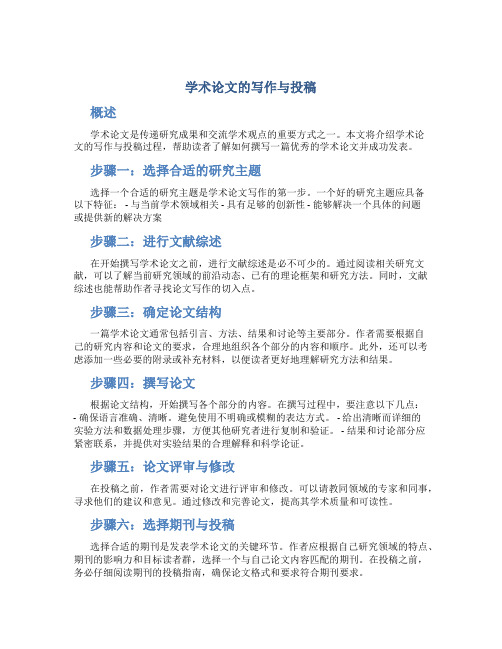
学术论文的写作与投稿概述学术论文是传递研究成果和交流学术观点的重要方式之一。
本文将介绍学术论文的写作与投稿过程,帮助读者了解如何撰写一篇优秀的学术论文并成功发表。
步骤一:选择合适的研究主题选择一个合适的研究主题是学术论文写作的第一步。
一个好的研究主题应具备以下特征: - 与当前学术领域相关 - 具有足够的创新性 - 能够解决一个具体的问题或提供新的解决方案步骤二:进行文献综述在开始撰写学术论文之前,进行文献综述是必不可少的。
通过阅读相关研究文献,可以了解当前研究领域的前沿动态、已有的理论框架和研究方法。
同时,文献综述也能帮助作者寻找论文写作的切入点。
步骤三:确定论文结构一篇学术论文通常包括引言、方法、结果和讨论等主要部分。
作者需要根据自己的研究内容和论文的要求,合理地组织各个部分的内容和顺序。
此外,还可以考虑添加一些必要的附录或补充材料,以便读者更好地理解研究方法和结果。
步骤四:撰写论文根据论文结构,开始撰写各个部分的内容。
在撰写过程中,要注意以下几点:- 确保语言准确、清晰。
避免使用不明确或模糊的表达方式。
- 给出清晰而详细的实验方法和数据处理步骤,方便其他研究者进行复制和验证。
- 结果和讨论部分应紧密联系,并提供对实验结果的合理解释和科学论证。
步骤五:论文评审与修改在投稿之前,作者需要对论文进行评审和修改。
可以请教同领域的专家和同事,寻求他们的建议和意见。
通过修改和完善论文,提高其学术质量和可读性。
步骤六:选择期刊与投稿选择合适的期刊是发表学术论文的关键环节。
作者应根据自己研究领域的特点、期刊的影响力和目标读者群,选择一个与自己论文内容匹配的期刊。
在投稿之前,务必仔细阅读期刊的投稿指南,确保论文格式和要求符合期刊要求。
步骤七:等待审稿结果一旦论文投稿成功,通常需要等待一段时间才能得到审稿结果。
审稿人会对论文进行评审和意见反馈,作者需要根据审稿人的建议对论文进行修改。
步骤八:回复审稿意见并投稿修改稿在收到审稿意见后,作者需要认真阅读审稿意见和评审报告,并做出合理的回复和修改。
学术论文写作与投稿指南
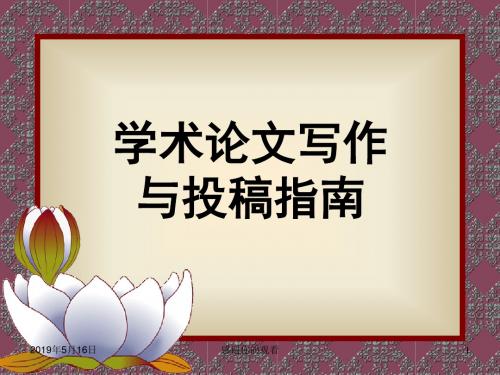
论等 D——动态性信息,包括通讯、报道、会议活动、专访等 E——文件、资料,包括历史资料、统计资料、机构、人物、
书刊、知识介绍等 文献标识码这项工作一般也是由编辑来完成的
30
主体部分
主体部分包括:引言、正文、结论、致谢和 参考文献等项目
14
执笔写作
按照提纲的顺序依次写作。提纲脉络 这就要求写 作者的思路要清晰,对材料对论题的驾驭能力比较 强。
各个击破的方式。根据论文提纲的逻辑关系,把论 文分成若干个相对独立的部分,从自己感觉准备最 充分的部分开始动笔,一部分一部分地完成初稿。 但是,这种方式,由很重要的一点,那就是,在写 完后,一定要通篇全读通篇进行整合,以防止各自 独立不成体系的问题。
25
作者署名
学术论文的标题之下,通常应标署作者姓名。 这是文责自负和拥有知识产权的标志,也便 于读者与作者保持联系。作者署名,可以是 笔名,或者是一个研究机构、课题小组的名 称。如果是多个作者,各个姓名之间应用逗 号隔开;如果作者不是同一个单位人,还应 在姓名的右上角加注不同的阿拉伯数字序号 以区别开来。如:王涛⒈,刘成胜⒉
学术论文,简称为论文,凡是以科学、技术为内容,运用概 念、判断、 证明和反驳等逻辑思维手段,进行分析、阐明自 然科学的原理、定律和科学技术研究中的各种问题及成果的 文章,都属于学术论文的范畴。
2
学术论文的特点
学术性,又称理论性 创造性,衡量学术论文价值的根本标准 科学性 ,具有多重含义:
学术论文写作 与投稿指南
2019年5月16日
感谢你的观看
1
何为学术论文
《科学技术报告、学位论文和学术论文的编写格式》对学术 论文作了具体定义:“学术论文是某一学术课题在实验性、 理论性或观测性上具有新的科学研究成果或创新见解和知识 的科学记录;或是某种已知原理应用于实际中取得新进展的 科学总结,用以提供学术会议上宣读、交流或讨论;或在学 术刊物上发表;或作其他用途的书面文件。”
论文写作技巧与注意事项

论文写作技巧与注意事项一、引言在学术领域,论文写作是一项重要的任务。
良好的论文写作技巧将有助于提升论文的质量,并使读者更容易理解和接受论文的内容。
本文将介绍一些论文写作的技巧和注意事项,希望能对广大学术写作者提供一些帮助。
二、确定论文的结构在开始写作之前,学者们应该清楚地确定论文的整体结构。
一般而言,一篇论文应包括引言、文献综述、研究方法、实验结果和讨论、结论等部分。
每个部分都应该紧密地联系起来,确保论文的逻辑连贯性和完整性。
三、选择恰当的语言和风格恰当的语言和风格对于论文的写作至关重要。
首先,要确保使用准确的学术术语和专业术语,以便读者能够准确理解论文的内容。
其次,选择适当的句子结构和篇章结构,以确保论文的流畅性和易读性。
最后,要避免使用口语化的表达和过多的修辞手法,保持论文的严谨性和客观性。
四、合理引用文献在论文中,引用文献是非常重要的。
通过引用相关的文献,可以展示你对于该领域的研究了解,同时也能够提供研究的背景和依据。
在引用文献时,要遵循学术规范,包括采用正确的引用格式和准确的引文内容。
此外,引用的文献应来自可信的学术渠道,以增强论文的可信度和学术性。
五、注意数据和结果的准确性在论文中,数据和实验结果是支撑你的研究和结论的重要依据。
因此,务必确保数据的准确性和可靠性。
在实验过程中,要严谨地记录数据,避免任何可能的误差。
而在发表数据和结果时,要进行充分的分析和讨论,以便读者能够真正理解你的研究成果。
六、重视结论的逻辑性结论作为论文的最后一部分,应该准确总结研究的主要成果,并给出对研究领域的展望。
在撰写结论时,要注意语言的简洁明了,不要重复引言和结果部分的内容。
同时,结论部分应该具有逻辑性和说服力,使读者对你的研究成果产生深刻的印象。
七、反复修改和审校好的论文不是一蹴而就的,它需要经过反复修改和审校。
写完论文之后,要仔细审查论文的每一个部分,确保逻辑清晰,语句通顺。
同时,要关注拼写错误、标点符号的使用和格式的规范,以确保整篇论文的准确性和规范性。
MDPI干货分享超细致英文学术论文写作攻略——学术论文撰写方法与Tips(四),请查收!
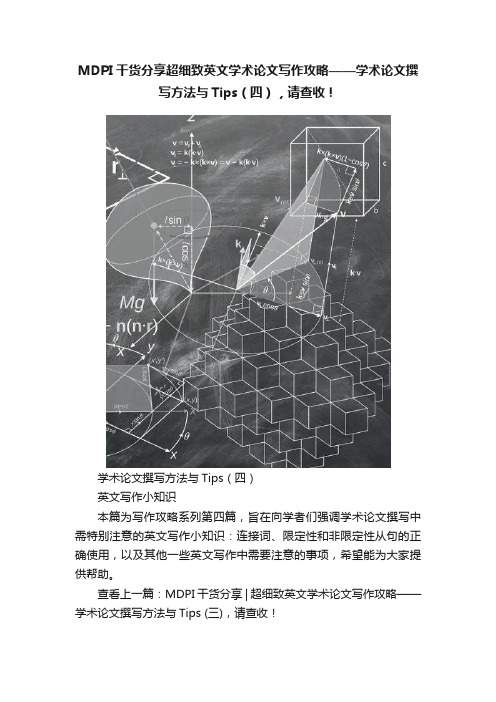
MDPI干货分享超细致英文学术论文写作攻略——学术论文撰写方法与Tips(四),请查收!学术论文撰写方法与Tips(四)英文写作小知识本篇为写作攻略系列第四篇,旨在向学者们强调学术论文撰写中需特别注意的英文写作小知识:连接词、限定性和非限定性从句的正确使用,以及其他一些英文写作中需要注意的事项,希望能为大家提供帮助。
查看上一篇:MDPI 干货分享 | 超细致英文学术论文写作攻略——学术论文撰写方法与Tips (三),请查收!5. 避免不必要的连接词英文写作中,应尽可能减少使用不必要的连接词。
请看下面例句:× We recorded all information online. Besides, they were published in a journal.√ We recorded all information online and published them in a journal.我们在线记录了所有信息,并发表在期刊上。
从以上例句中可以看出,第二句阅读和理解起来更容易。
因此,在英文写作中使用besides、therefore、thus等连接词之前,应该先思考一下这些词是否有必要。
6. 主谓一致要谨记英语写作中,“to be”的动词形式要与句子的主语保持一致,这一点非常重要。
如果有一个主语,则动词应该是is/was;而对于两个或两个以上主语的情况,动词则应是are/were。
请看下面例句:× The copper and manganese was heated.√ The copper and manganese were heated.将铜和锰加热。
第一个句子是错误的,因为有两个主语——铜和锰,所以不应该使用动词的单数形式。
如果这句话是“the copper was heated”或“the manganese was heated”,那么“was”就是正确的。
- 1、下载文档前请自行甄别文档内容的完整性,平台不提供额外的编辑、内容补充、找答案等附加服务。
- 2、"仅部分预览"的文档,不可在线预览部分如存在完整性等问题,可反馈申请退款(可完整预览的文档不适用该条件!)。
- 3、如文档侵犯您的权益,请联系客服反馈,我们会尽快为您处理(人工客服工作时间:9:00-18:30)。
Tips for Authors from Professor René M. Stulz[JFE Advisory Editor and former Editor of the Journal of Finance]Q1: What can I do to make acceptance of my paper more likely?A:Papers succeed or fail depending on their contribution to our field. However, authors should avoid simple mistakes which can substantially obscure their paper's contribution:A paper should be easy for the referee and the editor to read. This means it should be typed in a font large enough so that it can be read without magnifying glasses. It should be free from typographical errors. It should have no handwritten words or sentences. Referees typically do not take a paper more seriously than its author does. If the referee feels that you do not care about getting things right, he or she will become suspicious and be inclined to recommend rejection.Be careful to position your paper relative to the most recent related papers. Referees tend to dismiss papers when the author does not know and reference recent related published papers. For a paper to be published in the Journal of Financial Economics it has to make a significant contribution relative to the existing literature. The existing literature includes all published papers. Do not reference papers that are irrelevant to what you are doing - - even if they are my papers.Avoid insults and slights. It may well be that Professor X is an idiot, but unless the editor agrees with you, Professor X could be the referee of your manuscript.Do not fall into the trap of technobabble. The Journal is published in English. The abstract, introduction and conclusion should be clear enough that you could read them to a class of MBA students and they would understand why you wrote your paper and what one learns from it. In the main body of the paper, you should strive to explain things simply and use technical language only when it is necessary.Try to get input from colleagues before submitting a paper. They may help you in polishing your paper, correcting mistakes, and eliminating sources of confusion. Submitting a first draft is never a good idea. Most of the leaders of our profession polish and repolish their papers before submitting them -- at least one of them makes it a rule to not submit the first five drafts of a paper.Never look at a paper as a line in a resume. A paper should advance our field. If you do not look at your paper that way, why should the referee? If the referee does not look at your paper that way, why should he or she recommend publication?Q2: I just received a referee's report. The referee is an idiot. What should I do?A:Set the referee's report aside for a couple of days. Most likely, after having thought about the referee's comments, you will conclude that at least some of his or her points should be taken seriously. If the referee has indeed misunderstood your work, you have to ask yourself why he or she did so. Was the paper poorly written? Were your thoughts unclear? If the referee thought your contribution to be small, is it because you failed to describe it properly? Is it because you misunderstood what you had done? In a rare case, the referee may have made an important mistake. If the editor saw the mistake, he will deal with this issue in his editorial letter. Sometimes, the referee makes an important mistake and the editor does not notice it. In this case, the best course of action is to inform the editor of the situation. Nothing is gained by using vituperative language. The Journal has clear procedures that are used in such cases and are described in the "Dispute Process."Q3: I just received a referee's report. The referee is not an idiot. What should I do with the report?A: If you received a letter inviting you or allowing you to resubmit the paper, you should decide whether you want to follow that course of action. Typically, you will have received an editorial letter telling you the conditions under which you can resubmit the paper. Usually, that letter will require you to "incorporate the comments of the referee" and perhaps make additional suggestions. Incorporating the comments of the referee means just that: You take the list of comments one at a time and take them into account in your revision. Sometimes you will have very good reasons not to incorporate a specific comment. When you resubmit, you should include a response to the referee where you explain how you took the comments into account and why. In your letter of resubmission, you should tell the editor how you took into account his comments. In revising a paper, it is best to limit changes to what is required in the editorial letter. Making dramatic changes in a paper that are asked for neither by the referee nor the editor is a recipe for frustration unless these changes are necessary to correct mistakes or to incorporate recent contributions to the field.Sometimes the referee and/or editor provides feedback about a general problem with your paper (e.g., it is verbose). In such cases you should work to respond to that criticism throughout the paper, not just in the specific instances or examples that are mentioned in the referee's report or the editor's letter.Q4: What is the role of the Advisory and Associate Editors?A: They are active referees who typically consider between 3 and 8 papers a year. In addition, they are trusted advisors for the Managing Editor.Q5: Does it help to have my dissertation advisor lobby the editor?A:No. Papers get published because they contribute to our field irrespective of the parentage or connections of their authors. Authors who published in the Journal come from everywhere ?private universities, public universities, colleges, federal government, Wall Street, foreign universities, foreign governments. The Journal strives to be open and accessible to all those who have a good paper.Q6: Why is the Journal biased towards authors from the U.S.?A: It is not. Papers from foreign authors are published all the time. The key to success for foreign authors is to make sure that their paper is written clearly in grammatically correct language. It is not enough that a paper is correct for it to be published. It has to make a significant contribution that can be understood by our readers. If an author has trouble writing a paper this way, a simple solution is often to make a small investment in hiring a text editor who can polish the author's manuscript and improve its chances of publication by making it clearer.Papers using foreign # are welcome. However, authors using such # should write papers that contribute to the field beyond replicating U.S. studies on a foreign #set. Authors should ask themselves: What is it that we learn from this #set about the way financial markets or corporations operate in general?Q7: How long does it take for a paper to be published from first submission to publication?A: It varies widely. The best way to accelerate the process is to revise a paper quickly and be responsive to advice given by the editor and the referee. Typically, an accepted paper will have undergone two or three revisions.Q8: I resubmitted my paper and received a report from a different referee. What is going on?A:The original referee may be incapacitated (for instance, he died or became a Dean).The editor wants the opinion of a referee with different knowledge from the first referee to make the paper converge faster. For instance, the first referee might have been a theorist and now the editor wants advice from an empiricist.Q9: How can I affect the choice of a referee?A:Every effort is made to assign to each paper the most appropriate referee. Authors can help the editor who assigns a referee by having an abstract, an introduction and a conclusion that are clear, precise, and reflect the contribution of the paper accurately. Strategic referencing is almost always unproductive: Omitting an author from the references hoping that, as a result, the editor will not think of asking him or her to referee the paper is generally noticed by the editor.Typically, the first referee asked to offer advice on a paper will respond with a referee's report. However, referees are busy and successful colleagues. If, when reading the paper, they find it difficult or impossible to understand because of poor and careless exposition, they may choose to return the paper without a report. In these cases, the author will have to wait longer for an editorial decision. Good exposition makes it more likely that the author will receive a quick editorial decision and that the referee and/or the editor will not misunderstand the paper.Q10: Does the Journal consider for publication papers previously made available as working papers on the internet?A: Yes. Making working papers available on the internet does not constitute publication for the purpose of submissions. Papers can be posted on the internet until the authors receive a final acceptance letter from the Journal.Q11: My paper has been accepted for publication at the Journal and I would like to keep making it available on the internet. What can I do?A: There are no restrictions on making abstracts of your accepted and/or published papers available on the internet. Accepted papers not yet published in the Journal are available on the internet through the Journal's homepage. You can refer readers of your homepage to the paper maintained on the Journal's server.Q12: I worry that my paper is highly theoretical. How do I know whether it is appropriate for the Journal of Financial Economics?A:No paper is too theoretical for the Journal of Financial Economics. Whether a paper is acceptable depends on its contribution to our understanding of finance relative to the cost of reading it.。
